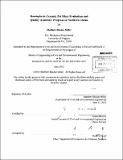Hemispheric ceramic pot filter evaluation and quality assurance program in Northern Ghana
Author(s)
Miller, Matthew Rhodes
DownloadFull printable version (17.54Mb)
Alternative title
Ceramic pot filter evaluation and optimization in Northern Ghana
Other Contributors
Massachusetts Institute of Technology. Dept. of Civil and Environmental Engineering.
Advisor
Susan Murcott.
Terms of use
Metadata
Show full item recordAbstract
Pure Home Water (PHW) is a non-profit based in Ghana that seeks to bring safe drinking water to those most in need in Northern Ghana through the production, sale, and distribution of ceramic pot filters (CPF) and other water, sanitation and hygiene innovations. This thesis documents the improvement of the performance of PHW's CPF in three areas; flow rate, bacteria removal, and strength. This thesis also documents the improvement of the PHW filter factory's quality assurance program primarily through the discovery of more efficient quality control measures. Of particular importance is the quality control measure known as the "First Drip Test" which accurately predicts both a CPF's flow rate and bacteria removal effectiveness. Two other tests, the "Bubble Test" and a tortuosity representation, were also found to be accurate quality control measures. In the production of CPFs, it was found that the percentage of combustible by mass, in this case rice husk, is the primary factor in determining both the flow rate characteristics and strength characteristics of the CPF. The flow rate increases linearly as the percentage of combustible used in the CPF composition increases. The strength decreases as the percentage of combustible used increases.
Description
Thesis (M. Eng.)--Massachusetts Institute of Technology, Dept. of Civil and Environmental Engineering, 2012. Cataloged from PDF version of thesis. Includes bibliographical references (p. 76-78).
Date issued
2012Department
Massachusetts Institute of Technology. Department of Civil and Environmental EngineeringPublisher
Massachusetts Institute of Technology
Keywords
Civil and Environmental Engineering.